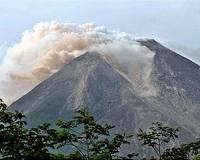| . |  |
. |
Ngaglik, Indonesia (AFP) Nov 14, 2010 Villagers forced to flee when Indonesia's most active volcano erupted in a series of killer blasts trickled back home Sunday even as rescuers dug out more bodies from mountains of ash. Indonesian authorities said the area around Mount Merapi remained on "red alert" as it continued to shoot huge clouds of ash into the air following eruptions that have claimed the lives of almost 250 people. But officials said they have reduced the danger zone around Merapi, one of dozens of active volcanoes on the archipelago that straddles major tectonic fault lines known as "ring of fire" between the Pacific and Indian oceans. Dozens of residents made their way back this weekend to Ngaglik, where a blanket of thick grey ash shrouded almost everything in sight -- homes, trees and roads, as well as rice and chilli fields. The village lies about 12 kilometres (seven miles) south of the volcano's peak and is still within the danger zone, but residents say they have grown restless staying in safety shelters. Nearly 400,000 people have fled their homes since Mount Merapi began erupting late last month, forcing them to live in cramped makeshift camps away from the disaster zone in central Java island. "I couldn't stand staying at the shelter any longer. I want to go back to a normal life," said 32-year-old farmer Suharti, who spent eight days in a temporary camp. "But it's hard now. My rice and chillies were all burnt by the searing volcanic ash. They're worth 6.5 million rupiah (730 dollars). Now, I have to find money so I can farm again," she told AFP. Her roadside home has been turned into a "distribution post" by relief workers to give out food staples such as rice, eggs, sugar and oil to returning villagers. Children played as residents queued patiently for rations. "There's nothing to cook, all the crops were ruined," lamented Sugono, a farmer in his 40s. Merapi, a sacred landmark in Javanese tradition whose name translates as "Mountain of Fire", began erupting in late October. Disaster management agency spokesman Sutopo Purwo Nugroho put the overall death toll at 242, saying rescuers were still hunting for bodies. Heru Nugroho, a spokesman for Sarjito hospital in the nearby city of Yogyakarta, said that figure excluded eight bodies rescuers found in an ash-buried village Sunday. Many of the dead were buried under fast-flowing torrents of boiling hot gas and rock that incinerated villages when the volcano exploded on November 5 in its biggest eruption in over a century. Senior volcanologist Sukhyar said villages surrounding Mount Merapi remained on "highest red alert" but that the government had reduced the danger zone around the volcano, except on southern slopes still affected by heat clouds. "The energy of Merapi has reduced significantly since November 8... We only detected one or two heatcloud emissions," he told a press conference in Yogyakarta. "This is not a rash decision as we had carried out an evaluation based on our observations of the volcano," he added. With the exclusion zone reduced, thousands are expected to leave the shelters but Sukhyar said they must "stay vigilant as the danger is not over yet". "About 160 trucks are on standby to take the evacuees home. But let us clean up the volcanic ash from the areas first," he added. Borobudur, a ninth-century Buddhist temple complex that is one of Indonesia's most visited sites and lie only 40 kilometres from Merapi, remained closed on Sunday along with the airport serving Yogyakarta. Merapi killed around 1,300 people in 1930 but experts say the current eruptions are its biggest since 1872.
Share This Article With Planet Earth
Related Links Bringing Order To A World Of Disasters When the Earth Quakes A world of storm and tempest
 Volcano buries Indonesian farmers' savings
Volcano buries Indonesian farmers' savingsDukun, Indonesia (AFP) Nov 13, 2010 Indonesian farmer Ari Sutikno was a month away from harvesting his rice crop when Mount Merapi volcano buried it - and his family's income - under a layer of hot ash. Like thousands of other poor farmers across central Java, the 65-year-old father of three has lost everything to the destructive power of nature. His paddy field in Sanggrahan village, about 22 kilometres (14 miles) north ... read more |
|
| The content herein, unless otherwise known to be public domain, are Copyright 1995-2010 - SpaceDaily. AFP and UPI Wire Stories are copyright Agence France-Presse and United Press International. ESA Portal Reports are copyright European Space Agency. All NASA sourced material is public domain. Additional copyrights may apply in whole or part to other bona fide parties. Advertising does not imply endorsement,agreement or approval of any opinions, statements or information provided by SpaceDaily on any Web page published or hosted by SpaceDaily. Privacy Statement |